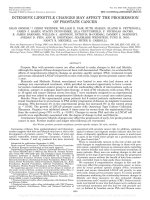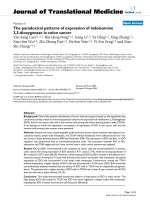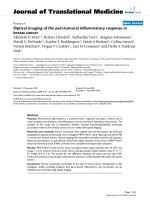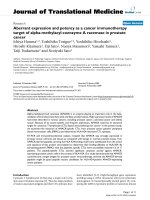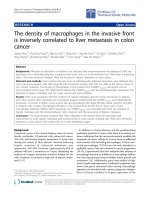ADVANCES IN PROSTATE CANCER docx
Bạn đang xem bản rút gọn của tài liệu. Xem và tải ngay bản đầy đủ của tài liệu tại đây (12.13 MB, 700 trang )
ADVANCES IN PROSTATE
CANCER
Edited by Gerhard Hamilton
Advances in Prostate Cancer
/>Edited by Gerhard Hamilton
Contributors
Glenn Tisman, Elba Vazquez, Geraldine Gueron, Javier Cotignola, Miguel Álvarez-Múgica, Ugo Rovigatti, Vildan Bozok
Çetintaş, Burçin Tezcanlı Kaymaz, Buket Kosova, Soon Cheol Ahn, Hak-Jong Choi, Kwang-Youn Kim, Sun-Nyoung Yu,
Sang-Hun Kim, Sung-Sik Chun, Yeong-Min Park, Yong-Lark Choi, Sun-Yi Lee, Prada, Peng Lee, Mandeep Singh, Yirong
Li, Garrett Daniels, Sujata Persad, Jacqueline R Ha, YuHao D Huang, Amit Persad, Meyers, Jutta Engel, Martin Dörr,
Anne Schlesinger-Raab, Guangchao Sui, Daniel Stovall, Mario Bernardo-Filho, Mauro Luis Barbosa Júnior, Adele
Holloway, Suyin Chin, Joanne L Dickinson, Luis Espinoza, Jorge Salvador, Vânia Moreira, Samuel Silvestre, Shinji Kariya,
Tine Hajdinjak, Luke Robles, Cheryl Dawn Helgason, Francesco Crea, Pier-Luc Clermont, Zachary Klaassen, Ray S. King,
Kelvin A. Moses, Rabii Madi, Martha Terris, Manuela Iezzi, Rossano Lattanzio, Alessia Lamolinara, Mauro Piantelli,
James Norris, Faik Atroshi, Sarah Rudman, Christopher Sweeney, Gerhard Hamilton
Published by InTech
Janeza Trdine 9, 51000 Rijeka, Croatia
Copyright © 2013 InTech
All chapters are Open Access distributed under the Creative Commons Attribution 3.0 license, which allows users to
download, copy and build upon published articles even for commercial purposes, as long as the author and publisher
are properly credited, which ensures maximum dissemination and a wider impact of our publications. After this work
has been published by InTech, authors have the right to republish it, in whole or part, in any publication of which they
are the author, and to make other personal use of the work. Any republication, referencing or personal use of the
work must explicitly identify the original source.
Notice
Statements and opinions expressed in the chapters are these of the individual contributors and not necessarily those
of the editors or publisher. No responsibility is accepted for the accuracy of information contained in the published
chapters. The publisher assumes no responsibility for any damage or injury to persons or property arising out of the
use of any materials, instructions, methods or ideas contained in the book.
Publishing Process Manager Iva Simcic
Technical Editor InTech DTP team
Cover InTech Design team
First published January, 2013
Printed in Croatia
A free online edition of this book is available at www.intechopen.com
Additional hard copies can be obtained from
Advances in Prostate Cancer, Edited by Gerhard Hamilton
p. cm.
ISBN 978-953-51-0932-7
free online editions of InTech
Books and Journals can be found at
www.intechopen.com
Contents
Preface IX
Section 1 Epidemiology and Etiology 1
Chapter 1 Epidemiology of Prostate Cancer 3
Martin Dörr, Anne Schlesinger-Raab and Jutta Engel
Chapter 2 Is There an Infectious Agent Behind Prostate Cancer? 19
Ugo Rovigatti
Section 2 Supporitve Care 61
Chapter 3 Psychological and Social Factors influencing Patients’
Treatment Selection for Localised Prostate Cancer 63
Luke A Robles, Shihning Chou, Owen J Cole, Akhlil Hamid, Amanda
Griffiths and Kavita Vedhara
Chapter 4 The Role of Physiotherapy in the Pre and Post Treatment
Interventions in Prostate Cancer Patients 79
Mario Bernardo Filho and Mauro Luis Barbosa Júnior
Section 3 Surgical Care and Radiation Therapy 103
Chapter 5 Abdominoperineal Resection: Consideration and Limitations
of Prostate Cancer Screening and Prostate Biopsy 105
Zachary Klaassen, Ray S. King, Kelvin A. Moses, Rabii Madi and
Martha K. Terris
Chapter 6 Radiation Therapy for Prostate Cancer 117
Shinji Kariya
Chapter 7 High-Dose-Rate Interstitial Brachytherapy as Monotherapy in
One Fraction for the Treatment of Favorable Stage
Prostate Cancer 145
Pedro J. Prada
Section 4 Prostate Cancer Markers 155
Chapter 8 Testosterone Measurement and Prostate Cancer 157
Tine Hajdinjak
Chapter 9 Describing Prostate Cancer Dynamics: Second Look at PSA-
Doubling Time and PSA-Specific Growth Rate 177
Glenn Tisman
Section 5 Medical Treatment 217
Chapter 10 Rational Categorization of the Pipeline of New Treatments for
Advanced Cancer – Prostate Cancer as an Example 219
Sarah M. Rudman, Peter G. Harper and Christopher J. Sweeney
Chapter 11 Novel Therapeutic Settings in the Treatment of Castration-
Resistant Prostate Cancer 251
Miguel Álvarez Múgica, Jesús M. Fernández Gómez, Antonio Jalón
Monzón, Erasmo Miguelez García and Francisco Valle González
Chapter 12 Steroidal CYP17 Inhibitors for Prostate Cancer Treatment: From
Concept to Clinic 275
Jorge A. R. Salvador, Vânia M. Moreira and Samuel M. Silvestre
Chapter 13 Intermittent Androgen Suppression Therapy for Prostate
Cancer Patients: An Update 305
Gerhard Hamilton and Gerhard Theyer
Section 6 Cell Biology of Prostate Cancer 331
Chapter 14 Stem Cells and Prostate Cancer 333
Vildan Bozok Çetintaş, Burçin Tezcanlı Kaymaz and Buket Kosova
Chapter 15 Salinomycin-Induced Apoptosis in Human Prostate
Cancer Cells 361
Hak-Jong Choi, Kwang-Youn Kim, Sun-Nyoung Yu, Sang-Hun Kim,
Sung-Sik Chun, Hak-Sun Yu, Yeong-Min Park and Soon-Cheol Ahn
ContentsVI
Chapter 16 Natural Compounds, Antioxidant and Antiandrogens in the
Prevention of Prostate Cancer: In vivo Evidences from Murine
Models and Human Clinical Studies 377
Rossano Lattanzio, Alessia Lamolinara, Mauro Piantelli and
Manuela Iezzi
Chapter 17 Prostate Cancer, Inflammation and Antioxidants 401
Marika Crohns, Tuomas Westermarck and Faik Atroshi
Chapter 18 Inflammatory Microenvironment in Prostate
Carcinogenesis 423
Geraldine Gueron, Javier Cotignola and Elba Vazquez
Section 7 Role of Androgen Receptor 463
Chapter 19 Expression and Function of Stromal Androgen Receptor in
Prostate Cancer 465
Mandeep Singh and Peng Lee
Chapter 20 Prostate Cancer Progression to Androgen Independent Disease:
The Role of the PI3K/AKT Pathway 473
Jacqueline R Ha, Yu Hao D Huang, Amit Persad and Sujata Persad
Section 8 Non-Androgen Gene Transcripts in Prostate Cancer 519
Chapter 21 Non-Androgen Regulated Transcription Factors as Novel
Potential Targets for Prostate Cancer Therapy 521
J. Nathan Davis, Adam H. Greer, Thomas Yong and Shari Meyers
Chapter 22 Trithorax Genes in Prostate Cancer 539
Pier-Luc Clermont, Francesco Crea and Cheryl D. Helgason
Chapter 23 The Function of YY1 and Its Oncogenic Role in
Prostate Cancer 563
Daniel B. Stovall and Guangchao Sui
Chapter 24 The Role of PARP Activation in Prostate Cancer 589
Luis A. Espinoza
Contents VII
Section 9 Cell Adhesion Proteins in Prostate Cancer 617
Chapter 25 Integrins in Prostate Cancer Invasion and Metastasis 619
Paulynn Chin Suyin, Joanne Louise Dickinson and Adele Frances
Holloway
Chapter 26 The Role of E-Cadherin-Catenin Complex in Prostate Cancer
Progression 639
Anuradha K. Murali and James S. Norris
ContentsVIII
Preface
“Advances in Prostate Cancer” is an addition to the InTech collection of three previous
books about prostate cancer and aims at providing a comprehensive overview of specific
aspects of the latest research and current knowledge relating to this tumor entity to
scientists and clinicians. For this purpose a series of research articles, clinical investigations
and reviews that deal with a wide range of relevant aspects pertinent to the epidemiology,
diagnosis, patient care, treatment and basic biology of prostate cancer were included.
Thereby this book aptly adds to the other InTech titles in the field of oncology, that describe
advances in cancer therapy, diagnosis and treatment of various cancers with reference to the
cancer stem cell concept.
The numerous participating authors of this book shared their expertise in epidemiology and
etiology, as well as supportive care, which comprises the handling of psychological
challenges and effects of physiotherapy in coping with the consequences of prostate cancer
treatment. State-of-the-art radiation therapy is moreover discussed as well as the
significance of testosterone and PSA measurements, the latter in form of a novel internet
“App” that helps to interpret the time course of the marker determinations on the outcome.
After many years of limited means to treat advanced prostate cancer several new agents
such as CYP17 inhibitors and new cytotoxic drugs, as well as a cancer vaccine, became
available, which poses new questions in regard to patient selection and appropriate choice
of medical care. These topics comprehensively discussed in several chapters are
supplemented by a review of the current state of intermittent androgen suppression versus
continuous hormone ablation. These chapters are complemented by a number of discussions
on the some characteristics of the cell biology of prostate cancer, including cancer stem cells,
inflammatory processes, roles of androgen receptor and diverse non-androgen gene
transcripts and, furthermore, cell adhesion proteins. This book is therefore destined to all
cancer researchers and therapists who intend to understand the current status of cell biology
and treatment of prostate cancer.
As editor of this book, I would like to acknowledge the significant efforts made by all of the
contributing authors for their excellent work as well as the entire Intech editorial team in
publishing of this volume. I would like to dedicate this book to the “Ludwig Boltzmann
Society” and, in particular, to Prof. Dr. Gerhard Baumgartner whose long-standing support
has allowed for the successful realization of many scientific projects. Last but not least, I
would like to thank my wife for her personal support and great patience at all times.
Gerhard Hamilton, PhD
Ludwig Boltzmann Cluster of Translational Oncology
Section 1
Epidemiology and Etiology
Chapter 1
Epidemiology of Prostate Cancer
Martin Dörr, Anne Schlesinger-Raab and Jutta Engel
Additional information is available at the end of the chapter
/>1. Introduction
This chapter presents the current state of prostate cancer epidemiology and compares data
from different regions. The data are taken from several sources:
Globocan 2008 [1] gives a glance on the worldwide situation in cancer epidemiology and
permits the comparison of more and less developed regions in every continent.
The “Surveillance, Epidemiology and End Results” Program (SEER) [2] in the USA and the
Robert Koch Institute (RKI) [3] in Germany present epidemiologic data of highly industrial‐
ized nations with maximally developed medical systems.
The Munich Cancer Registry (MCR) [4], a population-based clinical cancer registry of Upper
Bavaria, an area of 4.5 million inhabitants in the South of Germany, presents detailed analy‐
ses of clinical data, distributions of prognostic factors and therapy, and survival analyses.
Data of the MCR have also contributed to the publication “Cancer Incidence in Five Conti‐
nents, Volume IX” [5].
2. Incidence and mortality
In Table 1 absolute numbers and age-standardized rates of incidence and mortality are pre‐
sented for selected regions and countries [1]. In 2008 it was estimated that nearly every sev‐
enth case of male malignoma was prostate cancer (899 thousand new cases, 13.6% of the
total). Therefore, in men prostate cancer was the second most diagnosed cancer after lung
cancer. Approximately three quarters of these cases were diagnosed in more developed
countries. The highest incidence rates were measured in Australia, New Zealand, Northern
and Western Europe and Northern America. Moderate incidence rates were found in South
© 2013 Dörr et al.; licensee InTech. This is an open access article distributed under the terms of the Creative
Commons Attribution License ( which permits unrestricted use,
distribution, and reproduction in any medium, provided the original work is properly cited.
America and Eastern Europe. The lowest incidence rates were reported from South-Central
Asia.
Region
Incidence
absolute
Incidence
ASR (W)
Mortality
absolute
Mortality
ASR (W)
World 899 27.9 258 7.4
More developed regions 644 61.7 136 10.5
Less developed regions 255 11.9 121 5.6
Asia 133.2 7.2 59.6 3.2
North America 213.7 85.7 32.6 9.9
Central America 20.5 34.8 8.1 12.6
South America 84.1 50.2 29.2 16.2
Australia and New Zealand 21.0 104.2 4.0 15.4
Central and Eastern Europe 58.4 29.1 23.1 10.9
Northern Europe 64.9 73.1 17.4 15.4
Southern Europe 79.5 50.0 20.4 10.4
Western Europe 167.9 93.1 28.7 12.4
Germany 70.8 82.7 12.2 11.7
Japan 38.7 22.7 10.0 5.0
USA 186.3 83.8 28.6 9.7
Brazil 41.6 50.3 14.4 16.3
China 33.8 4.3 14.3 1.8
India 14.6 3.7 10.4 2.5
Russian Federation 22.1 26.1 9.5 10.8
SouthAfricanRepublic 7.5 59.7 2.5 20.8
Absolute numbers in thousands; ASR (W): age standardised rate per 100,000 by world standard
Table 1. Absolute numbers and age-standardised rates of incidence and mortality for selected regions and countries
[1]
Despite its high proportion of cancer diagnoses, prostate cancer is the cause of cancer specif‐
ic death in only every 16
th
case (258 thousand deaths, 6.1% of the total). This places prostate
cancer on the sixth position of cancer-specific causes of death, topped by lung, liver, stom‐
ach, colorectal and oesophageal cancer. These deaths occur almost equally in both, more de‐
veloped and less developed regions, thus leading to a twofold higher mortality rate in the
more developed regions.
Advances in Prostate Cancer
4
2.1. Incidence and mortality trends
Table 2 shows the current incidence and mortality of the USA [2], Germany [7, 8] and the
Munich Cancer Registry [4]. These rates have changed considerably over time. Time series
of more developed countries show that the incidence rates experience a drastic rise from
1985 to 1995 and remain at this high level. In the USA incidence (by world standard per
100,000) increases slowly from 1975 until 1985 (from 50 to 65). Then it rises rapidly reaching
a peak of 135 in 1992. Then it decreased, since 1995 more slowly, but it remains on a higher
level than before the peak (around 110). In Germany incidence is rising continuously since
1988 (from 30 to 75). The main explanation for these trends is the broad use of prostate spe‐
cific antigen (PSA) testing as a screening method and performing biopsies, which started in
the mid-1980s in the USA and in the early 1990s in Germany.
USA
(SEER, NCHS)
[2, 6]
Germany
(RKI)
[7, 8]
MCR
[4]
Absolute incidence 241.7 70.8 2.9
Crude incidence 157.7 145.1
Incidence ASR (W) 106.1 82.7 76.4
Mortality ASR (W) 10.2 11.7 13.3*
Lifetime risk(%) 16.2 13.0
Median age at diagnosis(years) 67.0 69.5 67.2
Median age at death(years) 80.0 76.7
5-year overall survival(%) 77.0 79.2
5-year relative survival(%) 99.2 92.0 93.4
10-year overall survival(%) 58.2
10-year relative survival(%) 98.3 87.8
Absolute numbers in thousands
ASR (W): age standardised rate per 100,000 by world standard
Incidence and mortality from cohorts of 2008 (all regions)
Absolute incidence numbers of the USA are estimates of SEER data from 2012
* Mortality ASR (W) for singular prostate cancers is 9.9
median ages from cohorts of 2005-2009 (all regions)
5-year survival from cohorts of 2002-2008 (SEER and MCR)
10-year survival from cohorts of 1998-2008 (SEER and MCR)
Table 2. Epidemiologic basic numbers
Epidemiology of Prostate Cancer
/>5
In the USA, mortality initially increases slightly from 1975 and since 1992 it is decreasing
more rapidly (from 14 over 17 to 10). In Germany the mortality rate (by world standard per
100,000) stays stable at 13.
2.2. Age distribution and age-specific incidence and mortality rate
Nearly all patients (≈ 99%) who are diagnosed with prostate cancer have reached an age of fif‐
ty or higher. The age distribution at diagnosis describes a positively skewed unimodal distri‐
bution with its modus at the age group 65-69. This age group contributes to nearly 25% of all
prostate cancer cases. The risk of getting prostate cancer increases nearly exponentially with
increasing age. This makes prostate cancer one of the most distinctive cancers in aging popu‐
lations (Figure 1) with a ASIR of 800-1000 per 100,000 in the elderly of 70 years and older.
0
200
400
600
800
1000
0-4
5-9
10-14
15-19
20-24
25-29
30-34
35-39
40-44
45-49
50-54
55-59
60-64
65-69
70-74
75-79
80-84
85+
age at diagnosis (years)
ASIR per 100,000
0
5
10
15
20
25
age distribution in %
age distribution ASIR
Figure 1. Age distribution at diagnosis and age-specific incidence rate (ASIR) of prostate cancer (1998-2008) [4]
Nearly all patients who died of prostate cancer (singular initial malignoma) have reached an
age of fifty-five or higher. The distribution of age at death describes a negatively skewed un‐
imodal distribution with its modus at the highest age group 85+. Here the age-specific mortal‐
ity rates (ASMR) can perfectly be described by an exponential function. The risk of dying by
prostate cancer increases accelerated with increasing age (Figure 2). The ASMR reaches 450
per 100,000 for men with an age of 80-84 and already 600 per 100,000 for men older than 84.
Advances in Prostate Cancer
6
0
150
300
450
600
750
0-4
5-9
10-14
15-19
20-24
25-29
30-34
35-39
40-44
45-49
50-54
55-59
60-64
65-69
70-74
75-79
80-84
85+
age at death (years)
ASMR per 100,000
0
5
10
15
20
25
age distribution in %
age distribution ASMR
Figure 2. Age distribution at death and age-specific mortality rate (ASMR) of prostate cancer (1998-2009) [4]
3. Prognostic factors
According to Table 3 the conditional age distributions of the combined T categories 2 until 4
have the same shape and the modus at the age group of 65 until 69. These distributions are
shifted slightly towards higher ages with the increasing T category. This simply reflects that
it takes time to develop an advanced tumour. However, in those patients diagnosed with T1
category (clinically) the age distribution appears to be totally different. Here 80% of the men
are older than 64 (about 60% within the other T categories) and every third man is older
than 74.
Lymph node category (N), distant primary metastases (M), Gleason Score, initial PSA value
and Gleason Score are positively correlated with the combined T category: the higher the T
category, the higher the PSA value, the higher the Gleason Score and the higher the porpor‐
tion of regional or distant metastases.
A positive lymph node status is mostly diagnosed when the tumour has spread through the
prostatic capsule. Nearly 20% of those men with T3 and almost 50% with T4 tumours there‐
fore are diagnosed with lymph node metastasis.
Epidemiology of Prostate Cancer
/>7
T category
All
%
(n=13712
100%)
T1
%
(n=1826
13.3%)
T2
%
(n=8219
59.9%)
T3
%
(n=3164
23.0%)
T4
%
(n=503
3.7%)
Age (years)
0.5 2.3 1.4 1.8 1.8<50
50 - 54 1.5 4.5 3.5 3.0 3.8
55 - 59 3.0 11.0 10.2 11.1 9.8
60 - 64 9.7 20.2 18.2 15.1 18.2
65 - 69 20.9 31.4 32.8 26.4 30.1
70 - 74 26.1 20.2 23.1 19.7 21.7
≥75 38.3 10.4 10.8 22.9 14.7
Lymph node status
2.5 1.6 18.4 45.1 7.3N+
N0 40.6 85.2 73.5 33.6 76.2
NX 56.9 13.2 8.1 21.2 16.5
Metastasis status
97.4 98.8 95.4 72.6 96.9M0
M1 2.6 1.2 4.6 27.4 3.1
PSA value (ng/ml)
25.8 13.2 7.8 3.7 13.2< 4
4 - <10 42.0 60.7 41.5 18.9 52.4
10 - <20 17.5 18.3 24.9 15.7 19.7
≥20 14.7 7.8 25.7 61.8 14.8
Gleason Score
14.3 1.6 0.2 0.2 2.92 - 4
5 - 6 54.8 48.1 12.3 4.2 39.1
7 19.1 40.5 49.4 26.6 39.3
8 - 10 11.8 9.8 38.2 68.9 18.7
Presented numbers are column-wise percentages.
T category is a combination of cT and pT.
The disease cohort is limited to 2005-2009 to provide best current estimators.
Table 3. Prognostic factors by T category [4]
Advances in Prostate Cancer8
Although, only 2.4% of all prostate cancer cases have primary distant metastases, already
25% of the T4 patients are diagnosed with metastases.
About 50% of the men with prostate cancer have a PSA value of 4 to 10 ng/ml at initial diag‐
nosis.
According to Figure 3aa shift from capsule exceeding tumours to capsule limited tumours
took place in the 1990s. In the late 1980s about 15% of the diagnosed tumours were staged
T4, some 45% T3 and nearly 25% T2. In the 2000s only some 5% of the diagnosed tumours
were staged T4, good 20% T3 and about 60% T2. The T1 category was unaffected and oscil‐
lated around 12% during the whole time period. It seems that PSA-Screening has considera‐
bly lowered the proportion of locally advanced tumours.
0
10
20
30
40
50
60
70
1988
1989
1990
1991
1992
1993
1994
1995
1996
1997
1998
1999
2000
2001
2002
2003
2004
2005
2006
2007
2008
Year
Distribution of T category in %
T1
T2
T3
T4
Figure 3. Distribution of T category over time (n = 35544) [4]. T category is a combination of cT and pT.
4. Therapy
Table 4 presents in detail the effects of combined T category on the choice of therapy. Guide‐
lines [9] note that radical prostatectomy, radiation therapy and hormone therapy in combi‐
nation with radiation therapy are the main primary treatment options when the tumour
remains within the prostate capsule (T2) or does not invade nearby structures other than the
seminal vesicles or the bladder neck (T3). A spreading prostate cancer should be treated
with a hormone therapy. Active surveillance (AS) and watchful waiting (WW) are only note‐
Epidemiology of Prostate Cancer
/>9
worthy initial therapy strategies for tumours detected in an early stage. Although these are
accepted treatment options in localised prostate cancer, they are seldom chosen compared to
radical prostatectomy and hormone therapy. Transurethral resection of the prostate is not an
appropriate surgical treatment option in prostate cancer but its proportion in T1 category
(46.7%) indicates a greater proportion of incidentally found prostate cancers during a treat‐
ment of benign hyperplasia. Without further surgical or hormone therapy, one could classi‐
fy these cases into the AS or WW groups.
T category
All
%
(n=13712
100%)
T1
%
(n=1826
13.3%)
T2
%
(n=8219
59.9%)
T3
%
(n=3164
23.0%)
T4
%
(n=503
3.7%)
Initial therapy
74.9 65.9 31.3 61.8RPE
TUR 47.2 3.2 2.5 11.4 9.0
HIFU 4.5 3.4 0.8 0.2 2.8
XRT 16.6 6.1 9.8 12.7 8.5
Hormone 23.7 11.6 20.3 44.2 16.4
AS and WW 8.0 0.8 0.7 0.2 1.6
Presented numbers are column-wise percentages.
T category is a combination of cT and pT.
The disease cohort is limited to 2005-2009 to provide best current estimators.
RPE: radical prostatectomy, TUR: transurethral resection of the prostate, HIFU: high-intensity focused ultrasound, XRT:
radiation therapy, Hormone: hormone therapy, AS: active surveillance, WW: watchful waiting
Table 4. Initial therapy by T category [4]
As Figure 4 shows impressively, initial therapy strategies have changed noticeably over the
last 20 years. In the late 1980’s radical prostatectomy was the initial therapy in about 25% of
all treatments. Its rate increased continuously and finally reaches almost 60%, making this
the most selected initial therapy per year since 1995. The curve of hormone therapy devel‐
oped oppositely. To be more precise: hormone therapy was the most selected treatment till
1994. From 65% in 1989 it continuously decreased to now 20%. Radiation therapy (XRT)
slightly increased to 10% as initial therapy. Finally, within the whole time span transurethral
resection of the prostate (TUR) remains stable at a proportion of nearly 10%.
Advances in Prostate Cancer
10
0
10
20
30
40
50
60
70
1988
1989
1990
1991
1992
1993
1994
1995
1996
1997
1998
1999
2000
2001
2002
2003
2004
2005
2006
2007
2008
Year
Distribution of initial therapy in %
RPE
TUR
XRT
Hormone
Figure 4. Distribution of initial therapy strategies over time (n = 35544) [4]. RPE: radical prostatectomy, XRT: radiation
therapy, Hormone: hormone therapy, TUR: transurethral resection of the prostate
5. Survival
The following figures mainly present the relative survival (RS) curves, an estimator for the
cancer specific survival. This is calculated by dividing the overall survival (OS) of the ob‐
served cohort by the expected survival of a normal population with the same distribution
regarding birth-date and sex.
When looking at the influence of the year of diagnosis on the overall survival (Figure 5) or
relative survival (Figure 6) only the curve of patients with a diagnosis in the years 1998 until
1992 noticeably differs from the other ones. Here the 5- and 10-year relative survival was
85.0% and 74.3%, respectively. In the group of patients diagnosed between 1993 and 1997
the 5- and 10-year relative survival was 94.9% and 88.6% in the group of 1998-2002 the 5-
and 10-year relative survival was 94.0% and 84.1% and in the recent group of 2003-2008 the
5-year relative survival was 92.1%. Therefore, the following survival analyses are presented
for patients with a diagnosis between 1998 - 2008.
Epidemiology of Prostate Cancer
/>11
0
10
20
30
40
50
60
70
80
90
100
Years
0 1 2 3 4 5 6 7 8 9 10
%
Year of diagnosis
1988 - 1992
n=2305
7.5%
1993 - 1997
n=5551
18.0%
1998 - 2002
n=7140
23.1%
2003 - 2008
n=15906
51.5%
0
10
20
30
40
50
60
70
80
90
100
Years
0 1 2 3 4 5 6 7 8 9 10
%
Year of diagnosis
1988 - 1992
n=2305
7.5%
1993 - 1997
n=5551
18.0%
1998 - 2002
n=7140
23.1%
2003 - 2008
n=15906
51.5%
Figure 5. Overall survival by year of diagnosis (n=30902) [4]
0
10
20
30
40
50
60
70
80
90
100
110
Years
0 1 2 3 4 5 6 7 8 9 10
%
Year of diagnosis
1988 - 1992
n=2305
7.5%
1993 - 1997
n=5551
18.0%
1998 - 2002
n=7140
23.1%
2003 - 2008
n=15906
51.5%
0
10
20
30
40
50
60
70
80
90
100
110
Years
0 1 2 3 4 5 6 7 8 9 10
%
Year of diagnosis
1988 - 1992
n=2305
7.5%
1993 - 1997
n=5551
18.0%
1998 - 2002
n=7140
23.1%
2003 - 2008
n=15906
51.5%
Figure 6. Relative survival by year of diagnosis (n=30902) [4]. Relative survival is the quotient of overall survival and
expected survival and thus an estimator for the cancer specific survival.
Advances in Prostate Cancer
12
The complete cohort of prostate cancer patients with a diagnosis between 1998 and 2008
(Figure 7) shows a 5-year overall survival of 78.8% and a 10-year overall survival of 57.7%.
The relative survival is 93.6% and 84.1%, respectively. For comparison: SEER data show a 5-
year relative survival of 99.2% for patients diagnosed between 2002 and 2008 and a 10-year
relative survival of 98.3% for the cohort of 1998 – 2008.
Figure 8 presents the relative survival by the combined T category. As expected, patients
with a T2-staging perform better than patients with a T1-Staging. The 5- and 10-year relative
survival is 102.0% and 94.0% in T1, 104.9% and 108.8% in T2, 97.6% and 89.5% in T3 and
61.4% and 43.8% in T4, respectively. Relative survival can exceed 100%, because prostate
cancer patients benefit from the better treatment of comorbidities during aftercare.
Lymph node status (N category) is an important prognostic factor. As Figure 9 shows, a pos‐
itive lymph node status (N+) reduces the relative survival drastically (77.7% for 5-year and
61.9% for 10-year survival) compared to a 5- and 10-year survival of 105.5% and 107.5% in
N0. Nonetheless, prostate cancer patients benefit from radical prostatectomy in the situation
with lymph node metastases [10].
0
10
20
30
40
50
60
70
80
90
100
110
Years
0 1 2 3 4 5 6 7 8 9 10
%
Overall Survival
Relative Survival
Expected Survival
0
10
20
30
40
50
60
70
80
90
100
110
Years
0 1 2 3 4 5 6 7 8 9 10
%
Overall Survival
Relative Survival
Expected Survival
Figure 7. Overall, relative and expected survival of the complete collective (1998-2008, n = 25773) [4]. Relative survival
is the quotient of overall survival and expected survival and thus an estimator for the cancer specific survival.
Epidemiology of Prostate Cancer
/>13
0
10
20
30
40
50
60
70
80
90
100
110
Years
0 1 2 3 4 5 6 7 8 9 10
%
T category
T1
n=2516
12.2%
T2
n=12110
58.5%
T3
n=5156
24.9%
T4
n=903
4.4%
0
10
20
30
40
50
60
70
80
90
100
110
Years
0 1 2 3 4 5 6 7 8 9 10
%
T category
T1
n=2516
12.2%
T2
n=12110
58.5%
T3
n=5156
24.9%
T4
n=903
4.4%
Figure 8. Relative Survival by T category (1998-2008, n = 20685) [4]. T category is a combination of cT and pT.
0
10
20
30
40
50
60
70
80
90
100
110
Years
0 1 2 3 4 5 6 7 8 9 10
%
N category
N0
n=14095
71.5%
NX
n=4306
21.8%
N+
n=1325
6.7%
0
10
20
30
40
50
60
70
80
90
100
110
Years
0 1 2 3 4 5 6 7 8 9 10
%
N category
N0
n=14095
71.5%
NX
n=4306
21.8%
N+
n=1325
6.7%
Figure 9. Relative Survival by N category (1998-2008, n = 19726) [4]. N category is a combination of cN and pN.
Advances in Prostate Cancer
14
0
10
20
30
40
50
60
70
80
90
100
110
Years
0 1 2 3 4 5 6 7 8 9 10
%
Gleason-Score
2 - 4
n=1138
5.2%
5 - 6
n=8872
40.8%
7
n=7420
34.1%
8 - 10
n=4329
19.9%
0
10
20
30
40
50
60
70
80
90
100
110
Years
0 1 2 3 4 5 6 7 8 9 10
%
Gleason-Score
2 - 4
n=1138
5.2%
5 - 6
n=8872
40.8%
7
n=7420
34.1%
8 - 10
n=4329
19.9%
Figure 10. Relative survival by Gleason Score (1998-2008, n = 21759) [4]
0
10
20
30
40
50
60
70
80
90
100
Years
0 1 2 3 4 5 6 7 8 9 10
%
PPS
1998-2008
n=2223
0
10
20
30
40
50
60
70
80
90
100
Years
0 1 2 3 4 5 6 7 8 9 10
%
PPS
1998-2008
n=2223
Figure 11. Post Progression Survival (1998-2008, n = 2223) [4]. Starting point of progression is from date of locore‐
gional relapse or distant metastasis (primary M1 or metastases in further course of disease).
Epidemiology of Prostate Cancer
/>15



